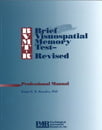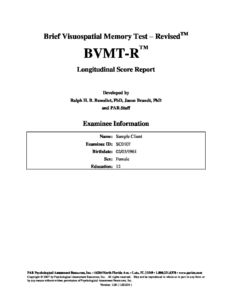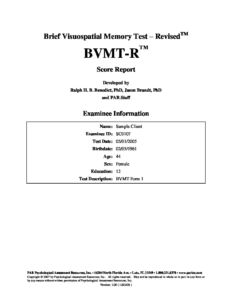
Brief Visuospatial Memory Test-Revised bvmt-r
For: Measure visuospatial memory in ages 18-79 years
Reading Level: Adult - Elder Adult
Format: Paper and Pencil
Length: 45 minutes timed (includes 25-minute delay)
Scoring: Hand Scored
Online Forms, Reports, Kits & e-Manuals
All online resources including Forms, Reports, i-Admins, Kits and e-Manuals.
Printed Kits
Click to browse products
Printed Forms & Handscoring Materials
Test forms, response booklets and scoring reference manuals.
BVMT-R online Score Report (each) min order 5
BVMT-R Introductory Kit
BVMT-R Response Forms (25)
Author
Ralph H. B. Benedict, PhD, ABCN
Description
The BVMT-R is designed for use as a criterion measure of visuospatial memory within a large battery of neuropsychological tests, as a screening measure within a brief neuropsychological battery and as a repeat measure to document changes in neurocognitive skills over time. It has been standardised and normed for use with adults ages 18-79 years.
BVMT-R materials were designed to be handled and transported easily, so that the test may be administered in a clinic setting or at the bedside using a clipboard. The materials include the Professional Manual, the Recall Stimulus Booklet, the Recognition Stimulus Booklet (easel format) and the Response Form. Administration requires a pencil and a stopwatch.
Each of the six equivalent, alternate BVMT-R stimulus forms consists of six geometric figures printed in a 2 x 3 array on a separate page of the Recall Stimulus Booklet. In the three Learning Trials, the respondent views the Recall Stimulus page for ten seconds and then is asked to draw as many of the figures as possible in their correct location on a page in the Response Booklet. After a 25-minute delay which includes primarily verbal activities, the task is repeated. Then, the respondent is asked to identify which of the 12 figures in the Recognition Stimulus Booklet were included in the six geometric figures on the original Recall Stimulus page. As a final step, an optional Copy trial may be administered to screen for severe visuoconstructive deficits and to help in scoring recall responses.
Normative data for the BVMT-R were derived from a sample of 588 normal participants that included 171 college students and 417 community respondents. Normative data is also provided for a 377-member subset of this normative sample, selected to reflect the age distribution of the U.S. population.
Reliability coefficients range from .96-.97 for the three Learning trials, .97 for Total Recall, and .97 for Delayed Recall. Test-retest reliability coefficients range from .60 for Trial 1 to .84 for Trial 3. The BVMT-R correlates most strongly with other tests of visual memory and less strongly with tests of verbal memory.
The BVMT-R Professional Manual contains information about the test materials and their development, administration and scoring, the normative standardisation sample, validity and reliability as well as guidelines for interpretation. The Appendixes provide scoring examples, normative tables for the U.S. census age-matched sample, demographically corrected norm tables based on the entire sample, and information on the base rate of impairment of BVMT-R scores in various clinical samples. For most diagnostic purposes, the use of demographically corrected normative scores is recommended.
HVLT-R/BVMT-R Professional Manual Supplement
The HVLT-R/BVMT-R Professional Manual Supplement provides information on the development, use and interpretation of several new scores, including Reliable Change scores and Discrepancy scores.
NB: Prices are in Australian dollars inclusive of GST. NZ customers need to log in to view ex-GST prices.
 NZ
NZ






